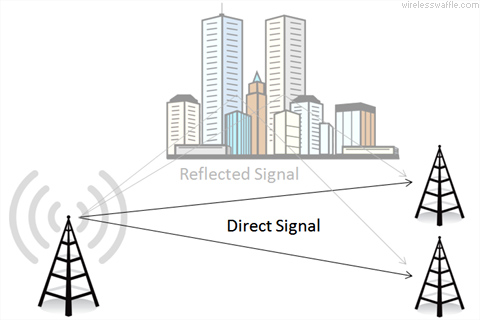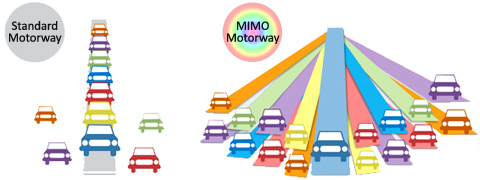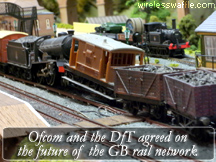Wireless Waffle intends to focus on developments in 5G mobile services amongst our usual flotsam and jetsam of scepticism and general incredulity over wireless matters. But what makes 5G different from 4G, or for that matter 4G from 3G? How are the ever faster connection speeds accomplished, and what are the implications for me and you? Over a series of posts, we intend to explain a little of what is behind these advances in mobile technology, which if nothing else, will serve to show just how sophisticated modern mobile networks are.
In old fashioned radio technologies, the transmitter uses a single antenna to emit a signal, and the receiver uses a single antenna to receive the signal (incidentally known as single input, single output or SISO). This works fine but neglects one of the most common propagation conditions that can upset reception of a radio signal: reflections. The reception of a signal reflected off an object in addition to the direct signal can lead to all manner of problems. One of the most common was, in the days of analogue television, what was known as 'ghosting'.
 Analogue television pictures are drawn line-by-line by a dot that whizzes across the screen from left to right. Any reflection will, by the simple laws of geometry, have travelled further than one directly from the transmitter and thus will take slightly longer to arrive. This produces a second image, that is 'delayed' compared to the direct signal, and this delayed picture would appear to the left of the main signal, as a ghost of the main picture.
Analogue television pictures are drawn line-by-line by a dot that whizzes across the screen from left to right. Any reflection will, by the simple laws of geometry, have travelled further than one directly from the transmitter and thus will take slightly longer to arrive. This produces a second image, that is 'delayed' compared to the direct signal, and this delayed picture would appear to the left of the main signal, as a ghost of the main picture.
In digital television, this problem has been dealt with by slowing down the transmission of the data, such that the typical length of a delay (measured in microseconds) is far less than the length of time used to send each bit, and thus you can effectively ignore the short period of time for which the delayed signal and the direct signal might be different from each other and switch off the receiver for a short while until the situation settles down. The time which the receiver waits for the situation to settle down is known as the guard interval and can be adjusted by the broadcaster to take account of different reflection environments (i.e. in a city where reflections tend to be strong, but over small distances, compared to in a rural area where the reflections might be from buildings or structures several kilometers away).

But what if you could be cleverer than just ignoring the reflection, and find a way of using it to benefit reception instead of being a detriment to it? Take the example illustrated above. A single transmitter is being received by two adjacent antennas, but as well as receiving a signal that has travelled directly from the transmitter, they are also receiving a reflection. If the signal being received at each antenna is compared with the other, the direct signal will appear identical, having travelled exactly the same distance. The reflection, however, will be different at each antenna, having travelled marginally different distances.
This fact can be used to do something very clever. If you compare the signals at both antennas, and only seek out the elements that are identical, you can effectively filter out the direct signal and throw away the reflection. However, you can go one step further. If you subtract the signal at one antenna from that of the other, the direct signal will cancel out, and you will be left with only the reflected signal. Thus it is possible to receive both the direct signal and the reflected signal independently from one another.
Now imagine you could tell the transmitter this information (i.e. that you were receiving two copies of the signal it was transmitting, one directly and one via a reflection). Using the same techniques but in reverse, it would be possible for the transmitter to send two independent sets of information, one via the direct path, and one via the reflection. You could use the same frequency twice between the same two points, doubling spectrum efficiency in one swipe. By using more antennas, more reflections can be handled and the same frequency can be re-used multiple times.
Such techniques are not science-fiction. One of the most important developments of recent years is the implementation of what is known as Multiple Input, Multiple Output (MIMO) technology. MIMO uses more than one antenna both at the transmitter and receiver to achieve exactly this outcome. One of the first widespread uses of MIMO was in the IEEE 802.11n standard for WiFi. This can use up to 4 antennas for the transmitter and up to 4 for the receiver. As reflections are common indoors (e.g. from walls, ceilings) this works very well and allows the same frequency to be re-used multiple times to achieve higher data throughput (theoretically up to 600 Mbps). This technique has been built into WiFi hotspots, laptops and mobile phones since the early 2010s and is now defacto in new devices.
 4G (LTE) also uses MIMO techniques to do exactly the same thing. It is becoming increasingly common for at least 4 antennas to be used at the base station and 2 or more in a mobile handset. Where 5G will change this, is that what is being called 'massive MIMO' will be employed. This means that the base station may have up to 256 antennas, and potentially something similar in handsets. This will allow the same frequencies to be reused hundreds of times within a cell, making spectrum efficiency very high, but also massively increasing the capacity of a cell and thus the connection speed experienced by the users.
4G (LTE) also uses MIMO techniques to do exactly the same thing. It is becoming increasingly common for at least 4 antennas to be used at the base station and 2 or more in a mobile handset. Where 5G will change this, is that what is being called 'massive MIMO' will be employed. This means that the base station may have up to 256 antennas, and potentially something similar in handsets. This will allow the same frequencies to be reused hundreds of times within a cell, making spectrum efficiency very high, but also massively increasing the capacity of a cell and thus the connection speed experienced by the users.
You might think that 256 antennas will weigh down cell towers, but as we are mostly talking about frequencies above 24 GHz, which have a wavelength of 1.2 cm or less, an array of 16 antennas high by 16 across (i.e. 256 in total) need only be 20 cm square. Even at lower frequencies such as 2.6 GHz which has a wavelength of 12 cm, and a panel of 4 antennas wide by 8 high, each antenna having both horizontal and vertical polarisation (making for 64 MIMO antennas) would only measure roughly 50 cm across and 1 m high, which is not that much bigger than traditional panel antennas used today. The picture on the left is of a 2.6 GHz MIMO panel antenna in use at the 5G Innovation Centre in the UK.
Another way to think about massive MIMO is to consider that with 256 antennas, you could use them in the same way as elements of a directional antenna, and form narrow beams pointing at each user. Each user could then use the full amount of spectrum that is available in the cell (or more if there are enough spare antennas to also handle the reflections). This is known as beamforming, and is one of the applications of MIMO.

The impact of massive MIMO has been likened to that of using a multi-lane motorway. On a standard motorway, each car shares a few lanes with other drivers and thus is constrained in what it can do by the other cars on the road. On a massive MIMO motorway, each car has its own lane and thus can do what it wishes.
There is one potential concern that MIMO brings. If you imagine all 256 antennas pointing in the same direction, the cumulative amount of radio energy being sent in that direction could be very high and some have expressed fears that this may exceed safety thresholds. The ITU has even held a workshop on the topic. The concerns also centre around the fact that it is foreseen that 5G cell deployments will be on structures such as street and traffic lights which put them much closer to pedestrians and drivers than existing deployments. Nonetheless, massive MIMO is a key part of 5G technology and will bring significant gains in spectrum efficiency.
In old fashioned radio technologies, the transmitter uses a single antenna to emit a signal, and the receiver uses a single antenna to receive the signal (incidentally known as single input, single output or SISO). This works fine but neglects one of the most common propagation conditions that can upset reception of a radio signal: reflections. The reception of a signal reflected off an object in addition to the direct signal can lead to all manner of problems. One of the most common was, in the days of analogue television, what was known as 'ghosting'.
 Analogue television pictures are drawn line-by-line by a dot that whizzes across the screen from left to right. Any reflection will, by the simple laws of geometry, have travelled further than one directly from the transmitter and thus will take slightly longer to arrive. This produces a second image, that is 'delayed' compared to the direct signal, and this delayed picture would appear to the left of the main signal, as a ghost of the main picture.
Analogue television pictures are drawn line-by-line by a dot that whizzes across the screen from left to right. Any reflection will, by the simple laws of geometry, have travelled further than one directly from the transmitter and thus will take slightly longer to arrive. This produces a second image, that is 'delayed' compared to the direct signal, and this delayed picture would appear to the left of the main signal, as a ghost of the main picture. In digital television, this problem has been dealt with by slowing down the transmission of the data, such that the typical length of a delay (measured in microseconds) is far less than the length of time used to send each bit, and thus you can effectively ignore the short period of time for which the delayed signal and the direct signal might be different from each other and switch off the receiver for a short while until the situation settles down. The time which the receiver waits for the situation to settle down is known as the guard interval and can be adjusted by the broadcaster to take account of different reflection environments (i.e. in a city where reflections tend to be strong, but over small distances, compared to in a rural area where the reflections might be from buildings or structures several kilometers away).

But what if you could be cleverer than just ignoring the reflection, and find a way of using it to benefit reception instead of being a detriment to it? Take the example illustrated above. A single transmitter is being received by two adjacent antennas, but as well as receiving a signal that has travelled directly from the transmitter, they are also receiving a reflection. If the signal being received at each antenna is compared with the other, the direct signal will appear identical, having travelled exactly the same distance. The reflection, however, will be different at each antenna, having travelled marginally different distances.
This fact can be used to do something very clever. If you compare the signals at both antennas, and only seek out the elements that are identical, you can effectively filter out the direct signal and throw away the reflection. However, you can go one step further. If you subtract the signal at one antenna from that of the other, the direct signal will cancel out, and you will be left with only the reflected signal. Thus it is possible to receive both the direct signal and the reflected signal independently from one another.
Now imagine you could tell the transmitter this information (i.e. that you were receiving two copies of the signal it was transmitting, one directly and one via a reflection). Using the same techniques but in reverse, it would be possible for the transmitter to send two independent sets of information, one via the direct path, and one via the reflection. You could use the same frequency twice between the same two points, doubling spectrum efficiency in one swipe. By using more antennas, more reflections can be handled and the same frequency can be re-used multiple times.
Such techniques are not science-fiction. One of the most important developments of recent years is the implementation of what is known as Multiple Input, Multiple Output (MIMO) technology. MIMO uses more than one antenna both at the transmitter and receiver to achieve exactly this outcome. One of the first widespread uses of MIMO was in the IEEE 802.11n standard for WiFi. This can use up to 4 antennas for the transmitter and up to 4 for the receiver. As reflections are common indoors (e.g. from walls, ceilings) this works very well and allows the same frequency to be re-used multiple times to achieve higher data throughput (theoretically up to 600 Mbps). This technique has been built into WiFi hotspots, laptops and mobile phones since the early 2010s and is now defacto in new devices.
 4G (LTE) also uses MIMO techniques to do exactly the same thing. It is becoming increasingly common for at least 4 antennas to be used at the base station and 2 or more in a mobile handset. Where 5G will change this, is that what is being called 'massive MIMO' will be employed. This means that the base station may have up to 256 antennas, and potentially something similar in handsets. This will allow the same frequencies to be reused hundreds of times within a cell, making spectrum efficiency very high, but also massively increasing the capacity of a cell and thus the connection speed experienced by the users.
4G (LTE) also uses MIMO techniques to do exactly the same thing. It is becoming increasingly common for at least 4 antennas to be used at the base station and 2 or more in a mobile handset. Where 5G will change this, is that what is being called 'massive MIMO' will be employed. This means that the base station may have up to 256 antennas, and potentially something similar in handsets. This will allow the same frequencies to be reused hundreds of times within a cell, making spectrum efficiency very high, but also massively increasing the capacity of a cell and thus the connection speed experienced by the users.You might think that 256 antennas will weigh down cell towers, but as we are mostly talking about frequencies above 24 GHz, which have a wavelength of 1.2 cm or less, an array of 16 antennas high by 16 across (i.e. 256 in total) need only be 20 cm square. Even at lower frequencies such as 2.6 GHz which has a wavelength of 12 cm, and a panel of 4 antennas wide by 8 high, each antenna having both horizontal and vertical polarisation (making for 64 MIMO antennas) would only measure roughly 50 cm across and 1 m high, which is not that much bigger than traditional panel antennas used today. The picture on the left is of a 2.6 GHz MIMO panel antenna in use at the 5G Innovation Centre in the UK.
Another way to think about massive MIMO is to consider that with 256 antennas, you could use them in the same way as elements of a directional antenna, and form narrow beams pointing at each user. Each user could then use the full amount of spectrum that is available in the cell (or more if there are enough spare antennas to also handle the reflections). This is known as beamforming, and is one of the applications of MIMO.

The impact of massive MIMO has been likened to that of using a multi-lane motorway. On a standard motorway, each car shares a few lanes with other drivers and thus is constrained in what it can do by the other cars on the road. On a massive MIMO motorway, each car has its own lane and thus can do what it wishes.
There is one potential concern that MIMO brings. If you imagine all 256 antennas pointing in the same direction, the cumulative amount of radio energy being sent in that direction could be very high and some have expressed fears that this may exceed safety thresholds. The ITU has even held a workshop on the topic. The concerns also centre around the fact that it is foreseen that 5G cell deployments will be on structures such as street and traffic lights which put them much closer to pedestrians and drivers than existing deployments. Nonetheless, massive MIMO is a key part of 5G technology and will bring significant gains in spectrum efficiency.
add comment
( 421 views )
| permalink
| 



 ( 2.6 / 927 )
( 2.6 / 927 )




 ( 2.6 / 927 )
( 2.6 / 927 )
Sunday 28 October, 2018, 09:38 - Much Ado About Nothing
Posted by Administrator
Posted by Administrator
 As it's that time of year again (which is to say late October), the time has come to give a plug to our ever growing list of One Hundred Halloween Hits. Whilst the list started out as just a hundred, it's now reached 130, so you are getting a bonus 30% free and for nothing. How good is that?
As it's that time of year again (which is to say late October), the time has come to give a plug to our ever growing list of One Hundred Halloween Hits. Whilst the list started out as just a hundred, it's now reached 130, so you are getting a bonus 30% free and for nothing. How good is that?Including such classic tracks as Thriller, Werewolves of London and Ghostbusters, if you are looking for the perfect playlist for your Halloween party this year, look, no further.
No, it's got nothing particularly to do with radio spectrum, or telecommunications but everyone needs a break, to let down their hair, put on a black cape, paint their face green and go from house to house demanding sweets (candy) from their neighbours occasionally don't they?
 For many years, Wireless Waffle has enjoyed the occasional bout of FM DXing. That is to say that when the propagation conditions have permitted, time has been enjoyably spent tuning up and down the FM band to see what can be heard.
For many years, Wireless Waffle has enjoyed the occasional bout of FM DXing. That is to say that when the propagation conditions have permitted, time has been enjoyably spent tuning up and down the FM band to see what can be heard.The logbook of this anomalous reception has been sitting waiting to be published for ages and now, with a quiet weekend with not much else to do has presented itself, it's finally morphed into a web-page of it's own.
Wireless Waffle is therefore proud to announce the FM DX Logbook. If this means nothing to you, then don't take a look. Even if it does, just one look is all it takes, as someone wiser and more lyrical once suggested.
Thursday 30 August, 2018, 14:45 - Spectrum Management, Much Ado About Nothing
Posted by Administrator
Posted by Administrator
 Ofcom has published a report called "Advice to Government on improving rail passenger access to data services, Spectrum for trackside connectivity solutions and rail passenger data demand". In it, they examine the amount of data needed to supply connectivity to passengers and then which spectrum band is best suited to supply these needs.
Ofcom has published a report called "Advice to Government on improving rail passenger access to data services, Spectrum for trackside connectivity solutions and rail passenger data demand". In it, they examine the amount of data needed to supply connectivity to passengers and then which spectrum band is best suited to supply these needs.The amount of data that each passenger will be consuming each month is taken directly from Ofcom's "Mobile Data Strategy" which was published in 2016. These range from 50 to 200 Gbytes per month in 2025 depending on the scenario. The report assumes that 80% of this data is offloaded onto WiFi and that it will be a WiFi service that is provided on the train.
 If this is the case, the average user will consume between 40 and 160 Gbytes of WiFi data per month, which is 1.3 to 5.3 Gbytes per day. If we take Ofcom's figures that there will be between 600 and 1440 passengers on busy commuter trains, and that a typical commute on a train lasts 1 hour, then the total amount of data per hour consumed by all the passengers between 33 and 315 Gbytes. This, in turn, equates to a connectivity requirement of between 73 and 700 Mbps. Of course, this assumes that every passenger on the train uses the WiFi service that is provided, which is unlikely to be the case, especially (as Ofcom also notes) if the service requires a payment to connect to.
If this is the case, the average user will consume between 40 and 160 Gbytes of WiFi data per month, which is 1.3 to 5.3 Gbytes per day. If we take Ofcom's figures that there will be between 600 and 1440 passengers on busy commuter trains, and that a typical commute on a train lasts 1 hour, then the total amount of data per hour consumed by all the passengers between 33 and 315 Gbytes. This, in turn, equates to a connectivity requirement of between 73 and 700 Mbps. Of course, this assumes that every passenger on the train uses the WiFi service that is provided, which is unlikely to be the case, especially (as Ofcom also notes) if the service requires a payment to connect to.Having presumably done the same calculations, Ofcom has arrived at a requirement of between 400 Mbps and 3.6 Gbps, or roughly 5 times more. So either train journey in Ofcom's world are 5 times longer, or people on trains are 5 times more hungry for data than normal individuals.
 Based on these figures, Ofcom have assumed that a benchmark connectivity speed should be around 1 Gbps for trains. It has then gone on to analyse the various spectrum options, and decided that the only band that can deliver the necessary connectivity is the 26 GHz band, which is one of the bands being touted for future 5G services. It completely excludes, for example, the use of the 2.7 - 2.9 GHz band as it claims that this could only deliver 100 Mbps of connectivity (assuming that 40 MHz of it could be made available). It also discounts the 5.4 GHz band as this could only deliver 'a few hundred Mbps'.
Based on these figures, Ofcom have assumed that a benchmark connectivity speed should be around 1 Gbps for trains. It has then gone on to analyse the various spectrum options, and decided that the only band that can deliver the necessary connectivity is the 26 GHz band, which is one of the bands being touted for future 5G services. It completely excludes, for example, the use of the 2.7 - 2.9 GHz band as it claims that this could only deliver 100 Mbps of connectivity (assuming that 40 MHz of it could be made available). It also discounts the 5.4 GHz band as this could only deliver 'a few hundred Mbps'. There are, though, significant issues with the 26 GHz band:
- Coverage of a 26 GHz 'cell' is expected to be a few 100 metres only, which would mean tens of thousands of cells would be needed to cover the UK rail network.
- Trains run at up to 200 km/h, this places extreme demands on handovers if cells are close together, let alone dealing with Doppler shift and Rayleigh fading.
- The 26 GHz band has been identified as a 'pioneer' band for 5G services in Europe and is likely to be in high demand from mobile operators for their future mobile services.
 There is, however, a very simple solution to the whole problem. If we shrink the size of the rail network to be only a few hundred metres long, then the 26 GHz solution will work perfectly. This, perversely, seems to be the plan of the Department for Transport who allow companies such as Southern, Thameslink, Hull Trains and Northern Trains to implement new timetables that effectively reduce the rail network to set of toys, that can't convey passengers anyway. Bravo, Ofcom, for realising that the rail industry will be reduced to OO-gauge before long anyway.
There is, however, a very simple solution to the whole problem. If we shrink the size of the rail network to be only a few hundred metres long, then the 26 GHz solution will work perfectly. This, perversely, seems to be the plan of the Department for Transport who allow companies such as Southern, Thameslink, Hull Trains and Northern Trains to implement new timetables that effectively reduce the rail network to set of toys, that can't convey passengers anyway. Bravo, Ofcom, for realising that the rail industry will be reduced to OO-gauge before long anyway.
